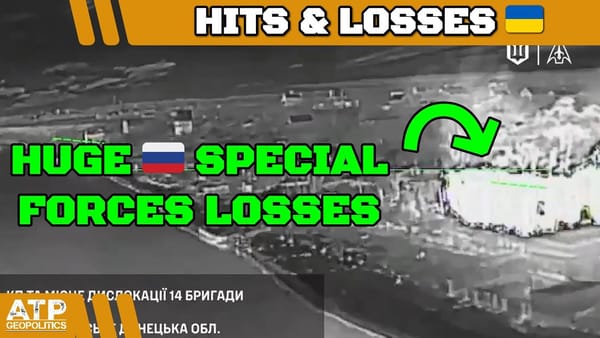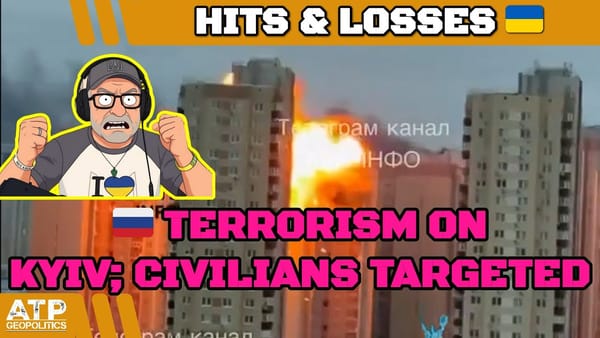Ukraine War Update NEWS: Pt 1 - Overnight & Other News
Table of Contents 📖
"Russia's GDP is less than the state of Texas. The fantasy that they can defeat NATO in a full-scale conventional war, everyone loses in a nuclear war, is preposterous."
Hello Team
🎦 00:00-00:19⏩
Jonathan welcomes viewers to another ATP Geopolitics video, a Ukraine War News Update for the 22nd of July 2024. He remarks on the busy last couple of days in the world of politics and the ongoing war.
Return to top⤴️
🪦 DISCLAIMER FOR GENERAL STAFF LOSSES DATA
- These are real people with real lives and real families who love them. Don’t let the numbers sap your humanity.
- These numbers probably aren’t accurate but they’re the best we have and we don’t need them to be accurate to be indicative of patterns of activity.
- All losses are estimates. Losses cannot be counted with accuracy because of the conditions on the ground.
- Both sides would see it to be of their advantage to minimize their own losses maximize the other side’s losses.
- Neither side releases their losses but we have enough transparency from the Ukrainian side to have confidence in they are indicative.
- Personnel losses are hard to count. If a soldier gets injured, heals up, and returns to the front line only to get injured again, is that one loss or two? Also, how to deal with losses from PMC’s or soldiers fighting with RF from occupied territories?
- Equipment losses are hard to count. If an AA complex involves several parts and one part gets disabled, is that a loss, or a fraction of a loss? If a tank gets disabled, repaired, back into the fight, then disabled again, is that one lost tank or two?
- All recorded losses are vulnerable to multiple reporting. We have already seen numerous cases of multiple drones in the air reporting the same loss from different angles as multiple engagements.
- Losses are not always reported on the same day they occurred. It is frequent that drone losses are reported at least 24 hours after other terrestrial equipment losses. Certain losses may not be reported for days or weeks for military intelligence reasons.
Ukrainian General Staff Reports Heavy Russian Losses
🎦 00:19-03:17⏩
Jonathan delves into the Ukrainian General Staff's figures for Russian losses. Key points include:
- Personnel losses exceeding 1,000, a significant increase.
- A substantial spike in Russian tank losses (18) compared to the previous day.
- High losses of artillery systems (51), more than three times the average.
- Record daily losses for vehicles and fuel tanks (102).
- Jonathan highlights the accuracy of the figures provided by Dell, who meticulously cross-references the data to avoid duplicates.
- He emphasizes that these vehicle losses inevitably translate into substantial personnel casualties.
Analysis of Ukrainian Equipment Losses
🎦 03:17-04:13⏩
Jonathan reviews Ukrainian equipment losses:
- Notes the first recorded loss of a Berger Panzer II recovery vehicle.
- Highlights the destruction of an M120K Rak, a Western-provided artillery piece, and an M777 howitzer.
- Reports an M1 Abrams tank damaged by a Russian night vision FPV drone.
- Observes that most other Ukrainian losses consist of civilian vehicles.
Russian Equipment Losses: Focus on Personnel Costs
🎦 04:13-07:53⏩
Jonathan analyses Russian equipment losses, emphasizing the human cost:
- Destruction of a Striz electronic warfare system and a ZIL-135 mine-laying vehicle.
- Loss of various artillery pieces, including a Nona-S and D-30s.
- Capture of a Russian T-80BVM tank, previously listed as abandoned.
- Significant losses of MTLBs and Tiger M APCs.
- Jonathan shows a video of an FPV drone strike on a Russian golf buggy carrying multiple personnel, emphasizing the often-overlooked human cost of these vehicle losses.
- He connects the high number of Russian vehicle losses with likely significant personnel casualties.
Zelensky Claims 20,000 Russian Casualties in Kharkiv Offensive
🎦 07:53-10:39⏩
Jonathan discusses Zelensky's claim of 20,000 Russian casualties in the Kharkiv offensive:
- He acknowledges the claim's pro-Ukrainian bias, advising viewers to exercise caution.
- Notes the claim aligns with the significant uptick in General Staff figures since the offensive began in May.
- Cites anecdotal evidence from a Russian soldier claiming heavy losses in Vovchansk, suggesting a pattern of similar accounts.
- Acknowledges the possibility of psychological operations (psyops) but suggests the volume of similar claims warrants consideration.
Russia Reinforces Kharkiv Despite Heavy Losses: Sunk Cost Fallacy?
🎦 10:39-11:58⏩
Jonathan examines reports of Russia reinforcing Kharkiv despite suffering heavy losses:
- Cites the Kiev Independent's report on Russia deploying additional assault units near the village of Shliobokay.
- Suggests Russia's actions may be driven by the "sunk cost fallacy", pouring more resources into a failing endeavour to recoup losses.
- He posits that General Lapan, in charge of the Kharkiv offensive, may be attempting to salvage his reputation after its disastrous outcome.
Russian Doomers Highlight Catastrophic Situation
🎦 11:58-14:45⏩
Jonathan discusses the emergence of "doomers" within Russia:
- Highlights a statement by Yevgeny Strigun, described as an ally of Russian propagandist Vladimir Solovyov, who characterizes the situation as catastrophic and apocalyptic.
- Notes Strigun's claim that assault operations result in far higher casualties than defensive ones.
- Mentions a claim from Russian state TV that Russia would need a million troops to achieve victory, a highly improbable scenario.
- Shares Strigun's reluctance to send young people to die, reflecting a growing sense of pessimism within Russia.
- Jonathan acknowledges the persistence of similar claims over time but emphasizes the consistent pattern of heavy Russian losses.
Motorcycle Assaults: Russia's Desperate Tactics
🎦 14:45-17:20⏩
Jonathan delves into Russia's use of motorcycle assaults, highlighting the desperation behind this tactic:
- He shares a report from WarTranslated's Dmitry on Russian propaganda promoting motorcycle assaults, noting complaints that this tactic wasn't implemented sooner.
- Confirms the existence of "motorcycle schools" and the formalization of this combat approach.
- Explores both the advantages and disadvantages of motorcycle assaults.
- Advantages include:
- Difficult to target individual riders with artillery.
- Potentially less prone to triggering mines.
- Disadvantages include:
- Lack of protection for riders.
- Limited carrying capacity.
T-62 Tanks: Russia's "Meat Tanks" Reflect Deep Equipment Problems
🎦 17:20-20:05⏩
Jonathan examines the deployment of outdated T-62 tanks by Russia:
- He questions the narrative of Russia's mass tank production, emphasizing the reliance on refurbished older models like the T-55 and T-62.
- Highlights the inferiority of the T-62M, even with upgrades, compared to modern Western equipment.
- Dubs these tanks "meat tanks" - disposable assets intended to bog down Ukrainian forces and deplete their resources.
- Argues that the use of such outdated equipment demonstrates Russia's inability to engage in modern combined arms warfare effectively.
- Draws parallels between these tactics and Russia's approach in World War II, emphasizing the key differences in Russia's geopolitical situation now compared to then.
- Concludes that without significant Chinese military aid, Russia faces a bleak prospect in a protracted war.
Analysis of Russian Artillery Stocks and Cannibalization Rates
🎦 20:05-22:43⏩
Jonathan examines open-source intelligence (OSINT) analysis of Russian artillery stockpiles:
- He credits Ben Tan Mai for his work analyzing satellite imagery of Russian storage bases.
- Notes the challenges in maintaining accurate counts due to cannibalization of parts from existing stockpiles.
- Highlights a Ukrainian source's estimate of 2,360 artillery systems remaining, with a projected depletion within 12 months based on current usage rates.
- Jonathan acknowledges the limitations of this estimate as it doesn't account for potential foreign aid or variations in cannibalization rates.
- He emphasizes the increasing difficulty and diminishing returns of cannibalization over time.
Ukrainian Army Faces Shortages of Short-Range Air Defence Systems
🎦 22:43-24:42⏩
Jonathan discusses the challenges faced by the Ukrainian Army due to a shortage of short-range air defence systems:
- He shares a statement by General Zaluzhnyi (Commander-in-chief of the Ukrainian Armed Forces) highlighting the army's struggles in countering enemy reconnaissance drones.
- Notes the increasing use of first-person view (FPV) drones and electronic warfare as countermeasures.
- Reports that the UK Ministry of Defence is expanding training for Ukrainian soldiers on the Martlet Man Portable Air Defence System (MANPADS) to address this shortage.
- He links this shortage to the extended Russian air support during the attacks on Avdiivka and Chasiv Yar, indicating a critical vulnerability.
Ukraine Launches Large-Scale Drone Attacks on Russian Targets
🎦 24:42-29:11⏩
Jonathan reports on significant Ukrainian drone attacks on Russian territory:
- He notes that Ukraine launched a wave of over 80 drones, targeting airbases and infrastructure.
- Russian sources claim to have shot down the majority of these drones, but successful strikes were confirmed.
- Confirmed targets include:
- An oil depot in Tuapse set ablaze (clear footage of the attack shown).
- Military airfield in Morozovsk (Rostov Oblast) hit, with reports of a fuel tank explosion.
- Primorsk-Akhtarsk airbase in Krasnodar region targeted, potentially a Shahid drone launch site or storage facility.
- Jonathan anticipates further details to emerge throughout the day as information becomes available.
Ukrainian Soldiers Hold Out for 70 Days Near Chasiv Yar
🎦 29:11-31:06⏩
Jonathan highlights the story of Ukrainian soldiers who held their position for an extended period:
- He recounts the story of eight Ukrainian soldiers who held out for 70 days in a forest near Chasiv Yar, supported by daring drone resupply operations.
- Their resilience prevented a potential Russian breakthrough and enabled other Ukrainian units in the area to receive crucial supplies.
Russian Economic Struggles: Rising Inflation and Interest Rates
🎦 31:06-32:15⏩
Jonathan touches on Russia's economic difficulties:
- Shares a report from WarTranslated's Dmitry indicating that the Russian Central Bank is likely to raise interest rates from 16% to 18% due to soaring inflation.
- He points out the significance of such high interest rates as a clear indicator of economic strain.
- He cautions viewers to be wary of potentially manipulated economic data from Russian sources.
Sverdlovsk: A Case Study in Russia's Hollow "Liberation"
🎦 32:15-34:15⏩
Jonathan uses the city of Sverdlovsk (Siverodonetsk) as an example to critique Russia's claims of "liberating" Ukrainian territory:
- He shows footage of the destroyed and abandoned city, captured by Russian forces more than two years prior.
- He criticizes the lack of reconstruction and investment in areas Russia claims to have "liberated."
- Contrasts the neglect in Sverdlovsk with limited rebuilding efforts in Mariupol, highlighting the inadequacy of these efforts.
- Condemns Russia's disregard for the welfare of civilians in captured territories, questioning the sincerity of their "liberation" narrative.
Wrap up
🎦 34:15-34:37⏩
Jonathan thanks viewers for watching and encourages them to like, subscribe, and share the video. He hints at the possibility of more content later in the day, potentially including a separate video on US politics and its relevance to the geopolitical landscape.
Return to top⤴️



